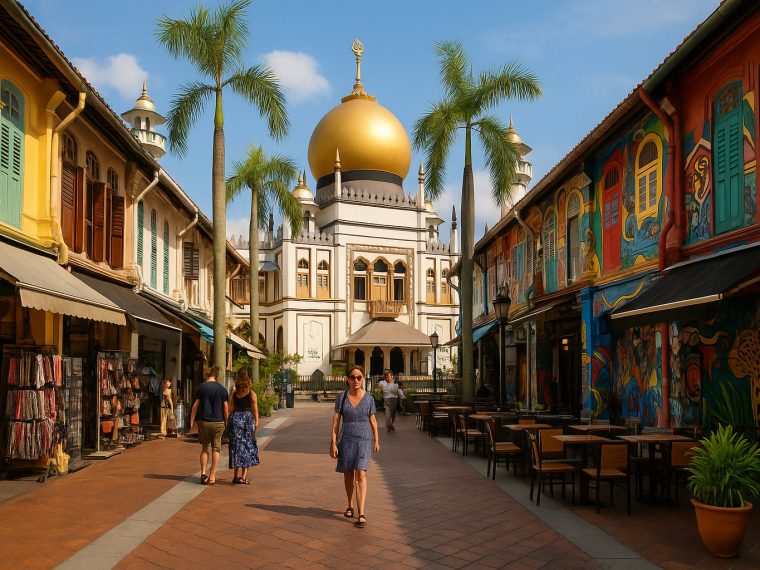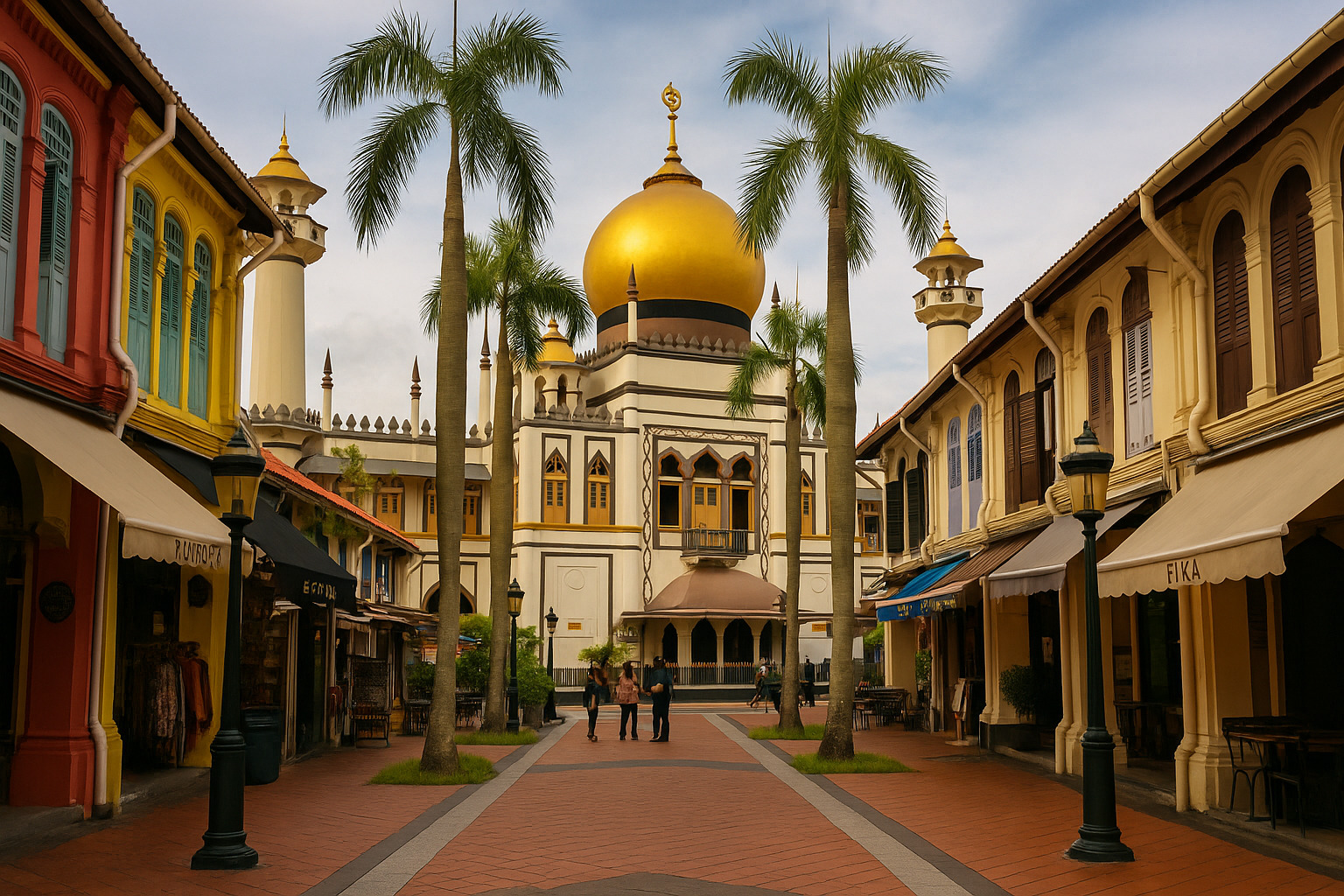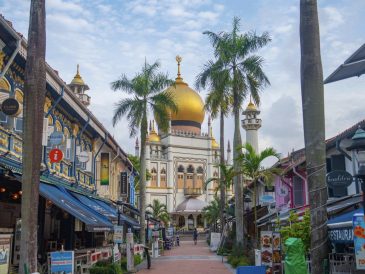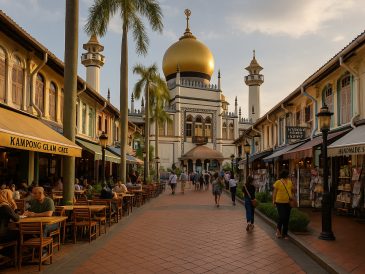Kampong Gelam is not a preserved fragment of history—it is living, breathing, and active. Its streets hum with centuries of tradition and present-day reinvention. If you’re searching for the answer to why this district still holds the title of Singapore’s cultural heart, it lies in its ability to hold fast to its identity while inviting new expressions into its fold.
A Royal Beginning
The roots of Kampong Gelam trace back to 1819, when Sir Stamford Raffles designated the area to Sultan Hussein Shah. This single act set the foundation for the district’s Malay-Muslim identity. The area soon became the royal seat of Malay sultans, with the Istana Kampong Gelam—now the Malay Heritage Centre—serving as a political and cultural nucleus.
The name “Kampong Gelam” itself comes from the Gelam tree, which once grew abundantly in the area. Far from a random title, the name reflects its indigenous heritage and deep ties to the land.
A Port Town of Cultures and Commerce
As the seat of Malay royalty, Kampong Gelam attracted migrants from Java, Sumatra, and the Celebes. Arab traders also laid down roots. This melting pot quickly grew into a bustling trade district. Textiles, spices, traditional medicines, and religious books filled the shopfronts.
It also played a logistical and spiritual role in the region’s Haj pilgrimage. Pilgrims from Southeast Asia often gathered here to prepare for the journey to Mecca, reinforcing Kampong Gelam’s status as a religious touchpoint for Muslims in the region.
The Sultan Mosque: Still the Center
Standing tall since 1824, the Sultan Mosque is both a physical landmark and a spiritual one. Commissioned by Sultan Hussein Shah, it was built in the Indo-Saracenic style, marked by its large golden domes and distinctive minarets. The mosque has not just endured, it has remained central to daily life and worship in the area.
Its visual dominance serves more than just aesthetics. It reminds passersby and pilgrims of Kampong Gelam’s original purpose and unwavering character.
The Malay Heritage Centre: A Living Archive
Where once stood the Sultan’s palace now resides the Malay Heritage Centre. This institution does more than just showcase relics. It tells the story of the Malay community’s place in Singaporean history through personal stories, cultural practices, and community contributions.
It also functions as a venue for events and workshops, continuing the tradition of cultural education within a heritage site.
The Harmony of Old and New
What separates Kampong Gelam from being a static museum piece is how effortlessly it balances heritage with creativity. Many businesses have been handed down through generations and still operate today. Batik stores, traditional barbers, and herbal remedy shops sit beside independent cafes and boutiques.
Even the buildings speak this dual language. The historic shophouses have been refreshed with bold murals by local and international street artists. Each wall is a canvas layered with contemporary voices atop historical foundations.
Street Art and Architecture
Kampong Gelam’s art doesn’t hide in galleries. It bursts from the walls of its streets. These murals tell stories of migration, spirituality, and local folklore. Rather than disrupt the area’s aesthetic, they amplify it.
Some highlights include:
- Muscat Street’s outdoor gallery: Mural-covered shophouses set against the backdrop of the Sultan Mosque.
- Aliwal Street’s creative zone: Artists and musicians often gather here, further blurring the lines between tradition and modernity.
A Culinary Crossroads
Few places in Singapore serve such a dense variety of cultural cuisine within walking distance. Kampong Gelam brings together traditional Malay, Javanese, and Middle Eastern dishes with modern interpretations.
Expect the scent of nasi padang and lamb mandi wafting through the alleys. Cafes now serve saffron lattes beside nasi lemak stalls. The district doesn’t replace the old recipes—it complements them.
What Keeps It Alive
Kampong Gelam does not depend on nostalgia. It thrives because it evolves without erasing. The reasons it remains Singapore’s cultural heart are found in how it keeps its past active rather than archived.
Key Factors That Sustain Kampong Gelam’s Cultural Relevance:
- Institutional Anchors:
- Sultan Mosque as a spiritual center.
- Malay Heritage Centre as an educational hub.
- Multi-Generational Businesses:
- Trade shops run by descendants of original settlers.
- Family-run eateries preserving traditional recipes.
- Contemporary Integration:
- Creative enterprises occupying heritage buildings.
- Public art as a form of cultural commentary.
- Community Functionality:
- Annual cultural events.
- Public spaces that serve both residents and visitors.
- Urban Continuity:
- Conservation of architecture.
- Active, not performative, cultural life.
More Than a Destination
Kampong Gelam isn’t merely a place people visit—it’s a place people return to. That loyalty comes from its unforced authenticity. Its evolution isn’t manufactured; it’s responsive. Each mural, mosque prayer, and menu item contributes to a story still being written.
As Singapore continues to change, Kampong Gelam holds its ground—not as a relic—but as an active, confident heart still beating in rhythm with its past and present.



